When seconds count during an emergency, they provide easy access to fire protection system controls and equipment
Most people hurry past it in the building they live or work in without giving it a second thought. But as the control center for a fire sprinkler system, the fire riser room plays a critical role in a building’s fire protection system—and knowing where it is, why it matters, and what equipment is stored inside can make all the difference during an emergency.
Until now, there hasn’t been a whole lot of information out there about fire sprinkler riser rooms that doesn’t require wading through pages of complicated fire and building codes. In this blog, we examine why riser rooms are important, what’s tucked behind their doors, and what the codes and standards require.
Be sure to check out our selection of pre-assembled fire sprinkler riser kits—making sprinkler system design and installation faster for commercial and residential applications, as well as riser clamps and fire sprinkler riser room signage that helps your riser room stay up to standard.
Fire sprinkler riser rooms: a dedicated space for fire protection equipment
In a nutshell, a fire sprinkler riser room is a dedicated space for fire protection equipment situated on an outside wall at grade with direct exterior access. It provides an accessible, single location for workers and emergency personnel to quickly locate fire sprinkler controls and equipment, including:
- The overall sprinkler riser, the main component of a sprinkler system that serves as a bridge between the water supply and sprinkler pipes in a building, and contains many of the following devices:
- Valves for draining, isolating, and testing the system
- Pressure gauges that measure whether sprinkler systems are in service and maintaining proper water pressure, as well as air pressure in dry sprinkler systems.
- The backflow prevention device, which protects municipal water supplies from pollution and contamination by only allowing water to flow in one direction
- In dry sprinklers, a dry pipe valve that holds back the water supply until a sprinkler head activates, as well as other dry system components like riser-mounted air compressors that pressurize sprinkler pipes
- A water flow switch that activates an alarm(s)
- The primary water input for the sprinkler system
- A water motor gong, or a fire alarm bell that sounds when water flows through the sprinkler system—often installed on the outside wall of the sprinkler riser room
- Tamper switches connected to fire protection valves that signal a warning if the valve partially or fully closes
- Piping that connects the system riser to the fire department connection, enabling firefighters to supplement the system’s water supply
- Often, the fire sprinkler spare head box and compatible sprinkler head wrenches for replacing deployed or damaged ones. It’s also helpful to store a copy of NFPA 25: Standard for the Inspection, Testing, and Maintenance of Water-Based Fire Protection Systems in the cabinet for reference during inspection or testing.
Watch this video for a tour of a typical fire riser room:
A large building could have multiple sprinkler systems that require multiple risers, making it important to carefully label the floor area each valve controls so workers and emergency personnel can quickly find the equipment they need. In fact, many fire departments require property owners to mount a building floor plan on the wall in the riser room that shows which control valves are responsible for each part of the building.
NFPA 13: Standard for the Installation of Sprinkler Systems also sets strict instructions for labeling critical equipment (like control valves) that’s located within the riser room. These requirements are discussed in detail in our previous blog, “Complete Guide to Sprinkler System Signs and Marking.”
Assembling the fire protection system controls in a single room is a convenience that can save precious time as an emergency unfolds. It can also help prevent costly water damage caused by accidental sprinkler discharges or leaks by enabling building personnel to quickly locate and shut off the correct control valve.
In some instances, the system’s fire pump and fire alarm control panel are also located in the sprinkler riser room, and additional fire signage is required if they are. And some local codes require riser rooms to house remote unit fire alarm panels connected to the master fire alarm panel in multi-family residential occupancies.
Rooms that include fire pumps also carry more robust construction and design requirements specified by NFPA 20: Standard for the Installation of Stationary Pumps for Fire Protection. Of course, not every sprinkler system requires a fire pump, and some fire industry professionals believe the most desirable location for the fire pump is in a separate building from the one being protected, giving firefighters easy access to the pump and its controllers and affording it the greatest protection from fires or other hazards that could hinder its operation.
Fire codes offer specific criteria for the design and construction of fire sprinkler riser rooms
Riser rooms are generally designated within apartment buildings, condominiums, commercial buildings, and other locations that rely on fire sprinkler or standpipe systems as the first line of defense for fire protection.
The International Code Council’s (ICC) International Building Code (IBC), the model building code that most U.S. jurisdictions have adopted as a base standard, doesn’t require riser rooms but offers specific criteria for their design and construction when they’re provided. Riser rooms also must meet the requirements of ICC’s International Fire Code (IFC), which addresses fire protection in completed, occupied buildings.
Many local codes expand upon these requirements with more detailed riser room mandates, so it’s always important to check with your specific authority having jurisdiction (AHJ) to ensure your property will pass muster. The intent of the code is to ensure protection for the equipment within these rooms since it’s continued operation is critical to safeguarding people and property during a fire.
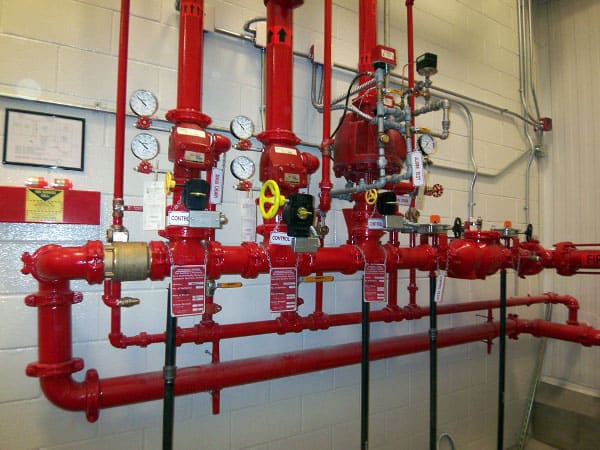
Regulations recognize that essential maintenance is challenging without proper clearance in riser rooms
In recent years, the ICC has continued to emphasize the importance of fire sprinkler riser rooms by expanding upon its requirements. In 2012, it required rooms housing fire protection systems to be adequately sized to facilitate maintenance. The code recognized that maintenance essential to a system’s longevity can be challenging if enough clearance isn’t provided to allow workers access for the removal of large or cumbersome components such as control valves or alarm check valves.
The IFC doesn’t specify its own measurements but defers to clearances specified by equipment manufacturers for installation or removal, with a goal of not having to remove doors, walls, or finishing materials within the riser room. It also states that the size of the door serving a riser room must be large enough to accommodate the removal of the largest piece of equipment it houses.
Many local regulations offer more specific measurements, such as these typical fire pump and riser room clearance amendments to the IFC from Lynnwood, WA’s 2019 Municipal Code:
“Such rooms shall be of a size that will allow a minimum of 36-inch clearance around all portions of the fire pump assembly and in front of the fire alarm panel(s). All risers shall have a minimum of 36″ clear space at the front and 18″ on the remaining sides.”
Based on the IFC and various local code requirements, it’s wise for building designers to work with fire protection system contractors early in the design process to ensure they create the necessary space and openings for equipment maintenance in riser rooms. A property’s fire protection system is usually designed around the time building construction drawings and specifications are reviewed by the AHJ.
From the 2018 edition of IFC
901.4.6 Pump and riser room size. Where provided, fire pump rooms and automatic sprinkler system riser rooms shall be designed with adequate space for all equipment necessary for the installation, as defined by the manufacturer, with sufficient working space around the stationary equipment. Clearances around equipment to elements of permanent construction, including other installed equipment and appliances, shall be sufficient to allow inspection, service, repair or replacement without removing such elements of permanent construction or disabling the function of a required fire-resistance-rated assembly. Fire pump and automatic sprinkler system riser rooms shall be provided with doors and unobstructed passageways large enough to allow removal of the largest piece of equipment.
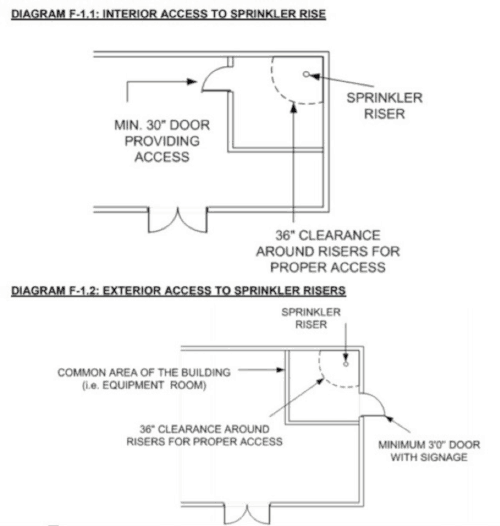
2018 fire code expands requirements
In 2018, the ICC emphasized the importance of riser rooms by adding even more requirements. The latest IFC code demands that riser rooms are easily accessible at all times through unobstructed passageways, but clarifies that they can be locked to prevent vandalism if a key is readily available to people who must access the room. Placing a key box listed to UL 1037 outside the room is a valid option.
From the 2018 edition of IFC
901.4.6.1 Access. Automatic sprinkler system risers, fire pumps and controllers shall be provided with ready access. Where located in a fire pump room or automatic sprinkler system riser room, the door shall be permitted to be locked provided the key is available at all times.
506.1 Where required. Where access to or within a structure or an area is restricted because of secured openings or where immediate access is necessary for life-saving or fire-fighting purposes, the fire code official is authorized to require a key box to be installed in an approved location. The key box shall be of an approved type listed in accordance with UL 1037, and shall contain keys to gain necessary access as required by the fire code official.
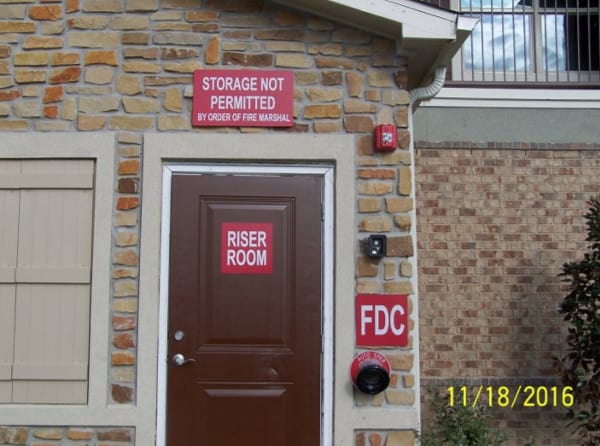
Signage
To ensure that a riser room is readily identified, the IFC requires signage on its access doors with letters that stand at least 2” in height and have a minimum stroke of 3/8”, so they are easily visible. Weather-resistant signs are also recommended. Once again, local ordinances may have additional requirements.
For instance, the Town of Brighton, N.Y., stipulates the following for fire sprinkler riser room signage: “7 inches high by 10 inches width with 0.5-inch letter stroke white reflective letters on a red background, and shall be permanently attached, at normal eye level to the door leading to the fire sprinkler control equipment.”
From the 2018 edition of IFC
901.4.6.2 Marking on access doors. Access doors for automatic sprinkler system riser rooms and fire pump rooms shall be labeled with an approved sign. The lettering shall be in a contrasting color to the background. Letters shall have a minimum height of 2 inches (51 mm) with a minimum stroke of 3/8 inch (10 mm).
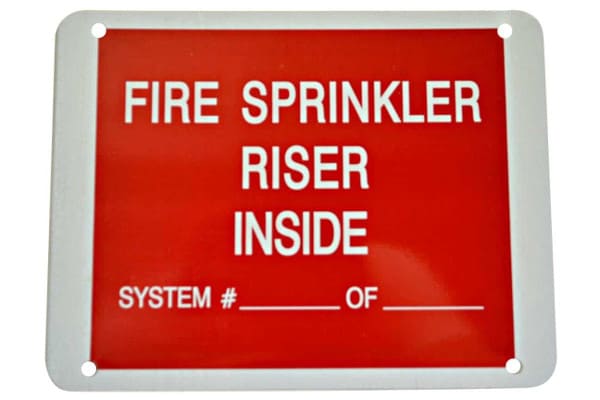
Environment
The IFC requires that the riser room’s ambient temperature be maintained at 40°F (4°C) or higher via a permanently installed heating device to ensure the system piping and components don’t freeze. This same temperature threshold is required for fire-pump rooms in NFPA 20 and valve rooms in NFPA 13. It is also the threshold NFPA 13 uses to determine whether dry sprinkler systems should be installed. Permanent lighting is now required in riser rooms as well.
From the 2018 edition of IFC
901.4.6.3 Environment. Automatic sprinkler system riser rooms and fire pump rooms shall be maintained at a temperature of not less than 40ºF (4ºC). Heating units shall be permanently installed.
901.4.6.4 Lighting. Permanently installed artificial illumination shall be provided in the automatic sprinkler system riser rooms and fire pump rooms.
And since dry systems have water in some of the pipes near the water source, NFPA specifically requires a lighted and heated valve room for dry sprinklers that shields the water pipes and dry pipe valve from cold.
The 2019 edition of NFPA 13 states that the dry pipe valve and supply piping must be kept in an area where the ambient temperature consistently stays above 40°F (4°C) (A.8.2.5.1). And the 2017 edition of NFPA 25: Standard for the Inspection, Testing, and Maintenance of Water-Based Fire Protection Systems requires daily inspections to ensure that the valve room is adequately heated when temperatures fall below freezing (13.4.5.1.1). Inspections can increase to weekly if a low-temperature alarm is installed (13.4.5.1.1.1).
From the 2019 edition of NFPA 13
8.2.5.2.1 Valve rooms shall be lighted and heated.
8.2.5.2.2 The source of heat shall be of a permanently installed type.
8.2.5.2.3 Heat tape shall not be used in lieu of heated valve enclosures to protect the dry pipe valve and supply pipe against freezing.
NFPA 13 qualifies that valve rooms aren’t necessary when dry valves are only exposed to cold temperatures for short, occasional snippets of time, however.
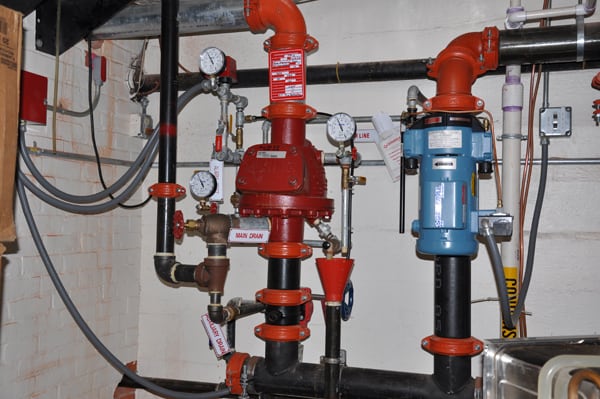
Improper use for storage
Facility managers and building owners should also keep this in mind: A common fire code infraction is cluttering fire sprinkler riser rooms with storage of non-fire protection equipment, such as file cabinets, shelving, buckets, and cleaning supplies. These extra items are not permitted because they can slow down accessing valves during an emergency when quick actions must be taken.
If fire pumps are operating within the room, it’s also imperative that both emergency and maintenance personnel have the space to work.
From the 2018 edition of IFC
509.2 Equipment access. Approved access shall be provided and maintained for all fire protection equipment to permit immediate safe operation and maintenance of such equipment. Storage, trash and other materials or objects shall not be placed or kept in such a manner that would prevent such equipment from being readily accessible.
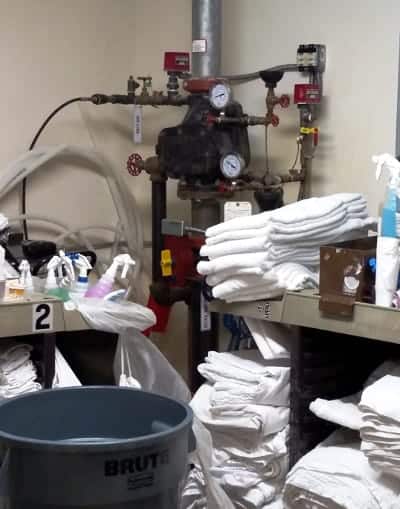
Central locations increase the efficiency of fire sprinkler systems
Sprinkler riser rooms must be located on the ground floor, with a door that’s directly accessible from the outside. But fire code also gives property owners some leeway in determining their exact location within a building.
Generally, riser rooms are situated where the water service enters a building, which is often predetermined by site conditions or local ordinances. But when possible, the location of the riser room should be carefully considered in a building’s design; a centrally located spot ensures a more efficient system and adequate water flow throughout a property. In fact, many local ordinances require centrally located riser rooms.
The riser room’s location can impact a sprinkler system’s installation costs as well. For instance, if the riser room is placed at the far end of a large industrial building, installers will most likely have to increase the pipe size to remote systems.
Important factors to consider when choosing a location for the riser room include:
- Easy access for the fire department
- The best hydraulic location for all systems
- Adequate space to access valves
- Location of the fire department connection or connections—as well as the domestic demand, if there’s a combined water service
Properly designed, cleared, and marked fire riser rooms can make all the difference during an emergency
When time is of the essence during an emergency, a clearly marked, unobstructed fire riser room can make all the difference, giving emergency personnel a central location to easily access a fire protection system’s controls. Understanding how to properly design and maintain these rooms—to protect the lifesaving equipment they contain—is key to ensuring fire sprinklers perform as intended during a fire.
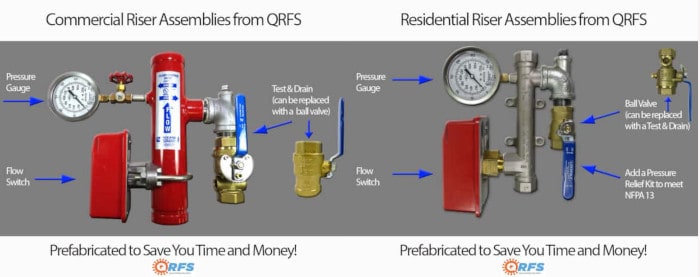
Be sure to check out our selection of pre-assembled riser kits—making sprinkler design and installation faster and sometimes less expensive for commercial and residential applications, as well as our fire sprinkler riser room signs that help ensure your riser room meets code.
Questions about QRFS products or need a brand or item that’s not in our online inventory? Just call us at +1 (888) 361-6662 or email support@qrfs.com.
This blog was originally posted at blog.qrfs.com. Check us out at Facebook.com/QuickResponseFireSupply or on Twitter @QuickResponseFS.


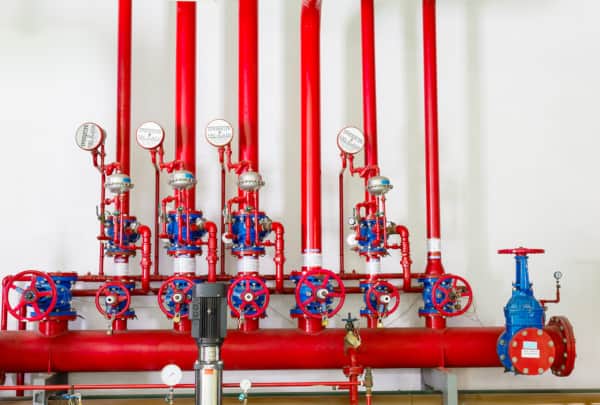

Great info. Wanted to ask about fire pump rooms. Is it possible to run conduits thru the room not serving the equipment inside. Any comments or input will be appreciated. Thanks.
Bob, thanks for reaching out. For questions like this that depend on your building type, we recommend submitting your question through QRFS Ask A Pro, qrfs.com/ask-a-pro. Click the link to submit your question with some information about your building or system, and a fire protection professional will provide a detailed answer based on standards and codes. Our pros include AHJs, contractors, engineers, and code experts with 150+ years of combined experience!
what is the code pertaining to having air louvers in the doors that access the fire riser rooms?
Brian, thanks for reaching out. For code questions like this, we recommend submitting your question through QRFS Ask A Pro, qrfs.com/ask-a-pro. Click the link to submit your question with some information about your building or system, and a fire protection professional will provide a detailed answer based on standards and codes. Our pros include AHJs, contractors, engineers, and code experts with 150+ years of combined experience!
Can you install new electrical equipment (heat trace panels, including distribution panel and floor mounted transformer in a dedicated fire equipment riser room?
Marian, thanks for reaching out. For code questions like this, we recommend submitting your question through QRFS Ask A Pro. Click the link to submit your question with some information about your building or system, and a fire protection professional will provide a detailed answer based on standards and codes. Our pros include AHJs, contractors, engineers, and code experts with 150+ years of combined experience!
can the riser room house networking equipment like a wifi access point if it does not restrict access the riser room equipment.
Bill — The general guidance from the IFC is that “storage” is prohibited in the riser room, and a WiFi access point could be interpreted as such by a fire inspector.
What if the storage is non combustible and there is a metal guardrail to provide access at all times to the fire riser? Because the code seems to state the storage cannot prevent access. If access is provided and it storage was non combustible wouldn’t it stand to reason that a fire riser could be share with that type of storage in a storage room? Any input is greatly appreciated! Thanks
Dave — Our best answer would be “maybe.” The IFC seems to provide some wiggle room to potentially have extra stuff in there, but it’s up to the judgment of the local AHJ. See below from the 2024 IFC (bolding/italics added to emphasize the potential wiggle room):
Hope that helps and thanks for reading!
What is the required fire rating for the riser room assembly?
John — thanks for reaching out. For questions like this, we recommend submitting your question through QRFS Ask A Pro. Click the link to submit your question with some information about your building or system, and a fire protection professional will provide a detailed answer based on standards and codes. Our pros include AHJs, contractors, engineers, and code experts with 150+ years of combined experience!
I live in an apartment and my in the building I am located in there has been an alarm that has been going off for months! I am a little concerned because I do not know why its going off and the leasing department said they cannot get into the room. They stated that they will need someone else to come in and see what is going on. Should I be concerned?
Carrington — We’re not sure if you are talking about a building alarm or a resident’s smoke alarm. If the former, no, it should not be going off all the time and you might want to contact the local fire authorities to ask about checking on it. If it’s simply a smoke alarm going off in someone’s residence, the unit could be defective or the individual is setting it off. In either case, the first option would be to work with your landlord, which it seems you’ve tried to do. Otherwise, contacting the local authorities may be an option. Good luck!
Does a door to a Fire Pump room need to swing out from the room? Or can it swing into the room?
Andrew — For specific codes and standards questions like yours, you can try our Ask a Fire Pro service. Click the link to submit your question with some information about your building, and a fire protection professional will provide an answer based on best practices, standards, and codes. Our pros include AHJs, contractors, engineers, and code experts with 150+ years of combined experience!
This is the answer o am lookout also
Hi,
Would you happen to have any general knowledge of whether riser rooms/sprinkler valve rooms are cleared to also serve as apartments (for renters)?
KF — Yes: the basic knowledge is that if a riser room is part of a functioning sprinkler system it cannot be used as a residence, break room, storage room, or anything else.
Can a Fire Alarm riser Room door be left open and with no one guarding it. We have maintenance personnel needing to work in that room all day but leave the door wide open.
Louis — For code questions like this, you can try our Ask a Fire Pro service (this would be the less expensive price tier). Click the link to submit your question with some information about your building, and a fire protection professional will provide an answer based on best practices, standards, and codes. Our pros include AHJs, contractors, engineers, and code experts with 150+ years of combined experience!
Hello I am a Plumber in Nevada with a question for you. Can a commercial plumbing company install 6″ fire riser mains to a building? Or do you need to be specifically certified for that?
Sal — In all cases, you must be qualified to install fire protection equipment (have related experience and training), and the system must be designed and parts specified by a qualified engineer/system designer. Whether or not you need to be licensed/certified is up to your state laws. We’d suggest contacting the Nevada State Licensing Board.
Hello, are there standards in place that requires all valves and pipe need to be labelled in the Riser Room?
Christian — most of what you describe is covered by NFPA 25’s requirement for a General Information sign in the riser room (corresponding to an “information sign” mentioned in NFPA 13), but there are also individual signs that can be placed to mark individual components, such as the locations of drains. Here are the NFPA 25 requirements (2020 edition) for the main sign at the riser:
4.1.9.1 A permanently marked metal or rigid plastic information sign shall be placed at the system control riser supplying an antifreeze loop, dry system, preaction system, or auxiliary system control valve.
4.1.9.2 Each sign shall be secured with a corrosion-resistant wire, chain, or other approved means and shall indicate at least the following information:
(1) Location of the area served by the system
(2) Location of auxiliary drains and low-point drains for dry pipe and preaction systems
(3) Presence and location of antifreeze or other auxiliary systems
(4) Presence and location(s) of heat tape
In regards to riser turn up, is there a minimum or maximum height requirement. So when you install the turn up with flang what is the hight requirement if any.
Matthew — For code and system application questions like this, you can try our Ask a Fire Pro service. Click the link to submit your question with some information about your building and system, and a fire protection professional will provide an answer based on best practices, standards, and codes. Our pros include AHJs, contractors, engineers, and code experts with 150+ years of combined experience!
Hello do riser rooms have to be cleaned ,like from dust debre trash, leaves spider webbs ets.
Adam — section 901.4.6 of the IFC outlines that riser rooms should be labeled, accessible, heated, illuminated, and kept free of anything that impedes access to equipment or clearance around it. So, for example, cleaning out significant “debris,” “trash” or any improper storage items is certainly required.
Do riser rooms require ventilation such as an exhaust fan?
James — We are unaware of any ventilation requirements specific to riser rooms, though the IFC specifies they must be climate controlled to avoid freezing temperatures. We suggest you read Chapter 9 of the IFC for more info. Thanks for reading!
I live in a 4 story condo building that has a secured “Sprinkler Room” on the ground floor, directly under the bedroom of my unit on the second floor.
There is a noisy mechanized process that runs in that room for 10 seconds every 20 minutes, 7X24.
I expect its purpose to maintain water or air pressure at a certain level.
Can you advise what that process and noise might be and how best to eliminate/reduce/dampen the bothersome noise?
Calvin — We can’t advise on what that noise is based on a description of it, though your guess may be correct — a fire pump (wet system) or an air-pressure-maintenance device (dry system) could be the culprit. Why it would be running at that interval is another matter we can’t assess. Bottom line: a fire protection professional needs to assess the situation onsite to address what’s going on. As for sound deadening, those are structural strategies mostly outside of the realm of fire protection; as long as things like acoustic paint or panels don’t violate fire codes and standards (e.g., don’t create obstructions in the riser room or are highly flammable substances), an expert in that area can make suggestions. However, getting a fire protection pro to evaluate the noise would be step one — an onsite evaluation will likely provide a simple answer. Thanks!
Can a triple wide trailer, used in a commercial construction office site setting, that has a designated riser room (approximately 12’ x 12’) contain metal cabinets 18” deep x 2’ wide x 6’ tall used to hang fall protection? The cabinets would be positioned against opposite walls from the riser equip. and alarm panel, leaving over 8’ of clearance in any direction for riser work?
Ric — You can consult a qualified fire protection professional in your area or try our Ask a Fire Pro service for an informal code interpretation. Click the link to submit your question with some information about your building or system, and a fire protection professional will provide a detailed answer based on standards and codes.
is there a new york violation code for opening the riser from the live side and causing a flood?
Malvina — Honestly, we are not familiar with every NY code but, more importantly, do not know what you mean by “opening the riser from the live side.” Are you talking about the main drain? If not, how was the riser “opened?” What was flooded? If you’d like, you can provide more detail via our Ask a Fire Pro service. Click the link to submit your question with some information about your building and system, and a fire protection professional will provide an answer based on best practices, standards, and codes. Our pros include AHJs, contractors, engineers, and code experts with 150+ years of combined experience!
In my apartment complex there is a riser room with a door in the parking area. There is a red spray painted box on the ground that extends out 15 ft. from the door (fire zone). It’s mentioned that the riser room must be unobstructed yet is that where the box ends in the spray paint?
======= < Riser room
|_ /_ /_|
|_ /_ /_| < Fire zone no parking
|_ /_ /_|
##
## < Car
is that considered obstructed or can it be parked since it's not in the red zone
Callisto — You should contact your local authority having jurisdiction (AHJ) to accurately assess your issue and determine which codes (including local rules) may apply. However, for example, the International Fire Code (IFC) reference mentioned above states: “Fire pump and automatic sprinkler system riser rooms shall be provided with doors and unobstructed passageways large enough to allow removal of the largest piece of equipment.” So, if a version of the IFC is adopted locally, it would depend on the equipment in the riser room and the distance between the door and a parked vehicle. Again, your local AHJ (you can start with the fire department) may provide a definitive answer. Thanks for reading!
Does the main valve on the riser need to be chained and locked in the open position if it a electric control valve that would take 45 turns for someone to close it on accident..all of the other ball valves are locked in the open position on each floor of the hotel..
the riser room is located on 1st floor in the boiler room and has no access for anyone un authorized to access..
The only reason I ask is because the insurance company wants me to chain the main valve in open position to avoid someone bumping it closed when it’s Pneumatic valve or would take a ton of turns to close and also has the emergency alarm when not in the all the open position
Robert — NFPA 25 (2023) presents locking or electrical supervision of control valves as an either/or requirement:
However, an insurance company can be an additional “authority having jurisdiction (AHJ)” that may have specific additional requirements to maintain coverage. You might point out the NFPA rules and situation, inquiring whether chains are necessary. However, they may simply want to ensure no one can tamper with the valve without a key.
I am responsible for maintenance at an apartment complex, and I have 11 Fire Riser rooms that need repairs. We need to remove and replace damaged drywall and clean rusted concrete caused by previous leaks that have already been repaired. My question is: Can I clean the rust and then paint over it with rust-inhibiting paint? Is this process in violation or am I clear to proceed with these repairs?
Alfredo — We cannot issue guidance regarding code compliance in this forum. However, a key question regards what you are painting with rust-inhibiting paint. There are no rules in NFPA standards about painting “rusted concrete;” the only rules govern not painting components of the fire sprinkler system. We strongly advise that you run the intended actions by a local fire sprinkler pro or your local authority having jurisdiction (e.g., the fire department/inspector).
do riser rooms need portable fire extinguishers in them?
Bob – We are not aware of any requirements in NFPA 10 (the portable extinguisher standard), NFPA 13 (the commercial sprinkler installation standard), NFPA 25 (the water-based system maintenance standard), or ICC codes calling for extinguishers in riser rooms—though we haven’t checked the latest editions of the latter. That said, check with your local AHJ or a fire protection pro, as local laws and regulations can vary. Thanks for reading!